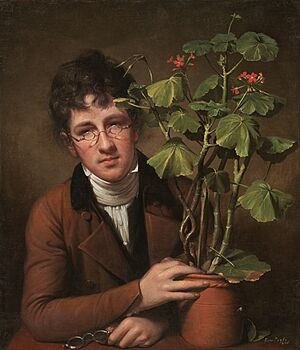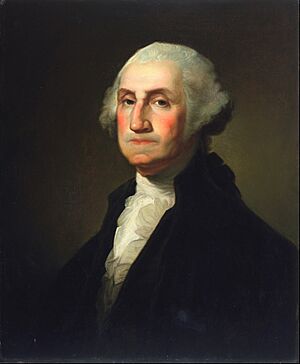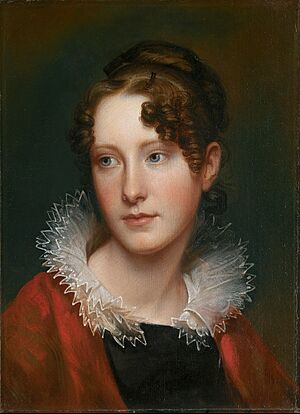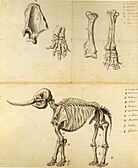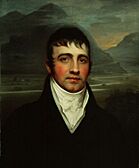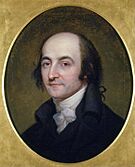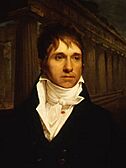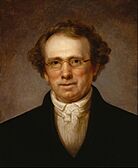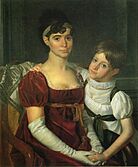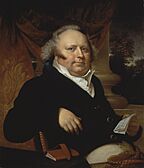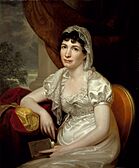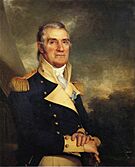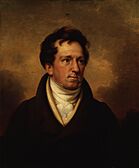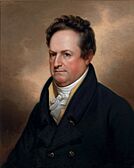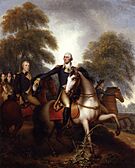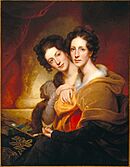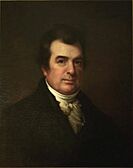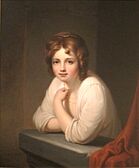Rembrandt Peale facts for kids
Quick facts for kids
Rembrandt Peale
|
|
|---|---|
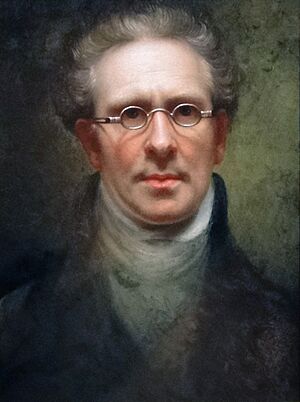
Self-portrait, 1828, Detroit Institute of Arts
|
|
| Born | February 22, 1778 |
| Died | October 3, 1860 (aged 82) Philadelphia, Pennsylvania, U.S.
|
| Education | Paris (1808), (1809–1810), Great Britain (1832) |
| Known for | Artist |
|
Notable work
|
Rubens Peale with a Geranium, George Washington, Patriae Pater, Court of Death |
| Movement | Neoclassical |
| Patron(s) | Charles Willson Peale, George Washington, Thomas Jefferson, Rubens Peale, John Marshall, John C. Calhoun, Charles Mathews, Jean-Antoine Houdon, DeWitt Clinton, Thomas Sumter |
Rembrandt Peale (born February 22, 1778, died October 3, 1860) was a famous American artist. He was also a museum owner. Peale painted many portraits, and he was especially known for his paintings of presidents George Washington and Thomas Jefferson. His art style, called neoclassicism, was inspired by French art after he visited Paris.
Contents
Growing Up and Learning Art
Rembrandt Peale was born on February 22, 1778. He grew up near Richboro, Pennsylvania. He was the third of six children who survived. His father, Charles Willson Peale, was also a well-known artist. He named Rembrandt after the famous Dutch painter Rembrandt van Rijn.
Rembrandt's father taught all his children to paint. This included his brothers Raphaelle Peale, Rubens Peale, and Titian Peale. Rembrandt started drawing when he was only eight years old. By age 13, he painted his first self-portrait. This painting showed how talented he was even at a young age. Later, he would show this painting to new artists to encourage them.
Becoming a Famous Artist
In 1787, when Rembrandt was nine, his father introduced him to George Washington. Young Rembrandt watched his father paint the future president. In 1795, at just 17 years old, Rembrandt painted Washington himself. This painting was very popular and helped Rembrandt start his career.
Painting George Washington
In 1822, Peale moved to New York City. He wanted to paint the best possible picture of Washington. He studied paintings by other artists, including his own father. His most famous painting of Washington, called Patriae Pater, was finished in 1824. It shows Washington looking out from an oval window. Many people think it's one of the best portraits of Washington.
Patriae Pater means "Father of Our Country" in Latin. The United States Congress bought this painting in 1832. Today, it hangs in the Old Senate Chamber. Peale made more than 70 copies of this painting. One copy, showing Washington in military uniform, is in the Oval Office at the White House. Peale also painted other important people, like President Thomas Jefferson and Chief Justice John Marshall.
Traveling for Art
Peale loved to travel to learn more about art. He visited Europe several times. His father helped him go to Paris in 1808 and again from 1809 to 1810. In Paris, he studied the works of Jacques-Louis David. This artist inspired Peale to paint in the Neoclassical style. He painted famous people like the explorer Alexander von Humboldt.
After his trips, Peale returned to Philadelphia in 1810. He painted The Roman Daughter in 1811. This painting showed a daughter feeding her imprisoned father. People in Philadelphia thought it was too shocking. They did not support his efforts to improve art in America.
Opening a Museum
Rembrandt Peale was inspired by his father, who had opened a museum in Philadelphia. In 1814, Peale opened his own museum in Baltimore, Maryland. This was the first building in America built specifically to be a museum.
His museum was special because it used gas lighting. This was a new invention at the time and made a big impression. Peale even got a patent for gas lighting. He helped start the successful Gas Light Company of Baltimore. However, he was not very good at business and left the company after a few years.
In 1828, Peale traveled to Rome to display his art. He took his 15-year-old son, Michael Angelo, with him. His son was also an artist and admired his father's work.
Rembrandt Peale passed away on October 3, 1860, in Philadelphia. He was 82 years old.
Famous Artworks
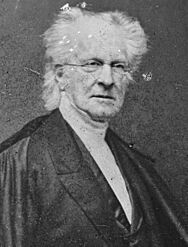
Rembrandt Peale was skilled at showing people's personalities in his paintings. For example, in his portrait of Margaret Irvine Miller, he showed her high social status through her clothes. But he also captured her strong, working-class spirit in her pose.
In 1801, Peale painted a portrait of his younger brother, Rubens Peale. Rubens loved gardening and nature. Rembrandt painted him sitting next to a geranium plant. This painting shows Rembrandt's respect for his brother's love of nature.
His famous painting Patriae Pater (1824) shows George Washington in an oval frame. This was the most successful painting of Peale's 50-year career. Even though Washington had already passed away when it was painted, many important people praised it.
Peale's painting The Roman Daughter (1811) shows kindness and protection. His large painting, Court of Death (1820), also shows his unique artistic style.
Family Life
When he was 20, Rembrandt Peale married Eleanor May Short. They had nine children together, including Rosalba, Eleanor, Michael Angelo, Angelica, and Emma Clara. After Eleanor passed away, he married Harriet Cany in 1840. Harriet was one of his art students and an artist herself.
Rembrandt Peale's Legacy
Rembrandt Peale created more than 600 paintings in his lifetime. He painted many important figures, including American presidents George Washington and Thomas Jefferson. His artworks are now displayed in many public art collections across the United States.
Where to See His Art
You can find Rembrandt Peale's paintings in many museums, including:
- The National Museum of American Art and National Portrait Gallery in Washington, D.C.
- The Peale Museum and Baltimore Museum of Art in Baltimore, Maryland.
- The Pennsylvania Academy of Fine Arts in Philadelphia, Pennsylvania.
- The Detroit Institute of Arts in Detroit, Michigan.
- The Dallas Museum of Art in Dallas, Texas.
Other Important Paintings
- Charles Willson Peale, Historical Society of Pennsylvania, Philadelphia, 1812
- Washington Before Yorktown, Corcoran Gallery of Art, 1824
- John C. Calhoun, Gibbes Museum of Art, 1834
- The Sisters, Eleanor and Rosalba Peale, Brooklyn Museum, 1826
- General Thomas Sumter, Independence National Historical Park, Philadelphia, 1796
- DeWitt Clinton, Historical Society of Pennsylvania, Philadelphia, 1823
Gallery
-
Thomas Jefferson (1800)
-
William Henry Harrison (1814)
-
DeWitt Clinton (c. 1823)
-
Washington Before Yorktown (1823)
-
Portrait of Dr. David Hosack (1826)
-
Raja Rammohan Roy (1833)
-
John C. Calhoun (1834)



